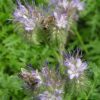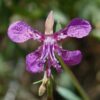Article-at-a-Glance
- Honeywort, also known as the blue wax flower, is a vibrant and hardy perennial that’s safe for dogs.
- It’s a low-maintenance plant that thrives in well-draining soil with full to partial sunlight.
- Aside from being dog-friendly, Honeywort is drought-resistant and attracts beneficial pollinators.
- Other dog urine resistant perennials include plants like Lavender, Marigolds, and Fescue grass.
- By choosing the right plants and following some simple steps, you can create a beautiful, pet-friendly garden space.

“QAUZUY GARDEN 50 Blue Shrimp Plant …” from www.amazon.com and used with no modifications.
Dive Right Into Hardy Perennials and Honeywort
When it comes to gardening with your four-legged friends in mind, choosing the right plants is essential. Not only do you want to ensure that your garden is a safe place for them to explore, but you also want to choose plants that can stand up to the occasional romp or marking. Honeywort, known for its striking blue-purple flowers and dog-friendly nature, is an excellent choice for your garden. Let’s explore why Honeywort, or Cerinthe major, should be a top pick for your dog’s play zone.
Benefits of Choosing Honeywort for a Dog-Friendly Garden
There’s a reason Honeywort is praised by gardeners who also happen to be pet owners. Firstly, it’s non-toxic to dogs, so you can rest easy knowing your furry friend is safe. Secondly, Honeywort is a robust plant that can tolerate a bit of trampling and the occasional dog urine without withering away. It’s this hardiness that makes it a favorite among those looking for dog-friendly perennials.
Moreover, Honeywort is not just tough; it’s also a delight for the senses. Its tubular flowers and silvery-green foliage add a splash of color and texture to any garden. And because it’s a magnet for bees and butterflies, you’ll be supporting the local ecosystem while enjoying the animated buzz of pollinators hard at work.
Growing Honeywort: A Step-by-Step Guide
- Start with quality seeds or plants from a reputable nursery to ensure healthy growth.
- Choose a spot in your garden that receives full to partial sunlight, as Honeywort loves the sun.
- Ensure the soil is well-draining; if not, amend it with organic matter like compost to improve drainage.
- Plant Honeywort seeds or seedlings following the spacing guidelines, usually about a foot apart.
- Water your Honeywort regularly until it’s established, then enjoy its drought-tolerant nature.
Remember, Honeywort is not only beautiful but also incredibly resilient, making it a perfect companion in your dog-friendly garden. With minimal care, you’ll have a garden that’s both beautiful and functional, offering a safe haven for your pets and a feast for the eyes.
Preparing the Soil for Planting
Before you introduce Honeywort to your garden, the soil must be ready to support its growth. Begin by loosening the soil to a depth of about 12 inches and mix in a generous amount of compost. This not only improves drainage but also adds vital nutrients that will give your Honeywort a strong start. The ideal pH for the soil should be neutral to slightly alkaline. If your soil is too acidic, consider adding some lime to balance it out. A well-prepared soil bed means your Honeywort plants will have the best chance to thrive, and in turn, create a lush and inviting space for your dog to enjoy.
Protecting Honeywort from Playful Paws
While Honeywort is quite resilient, a rambunctious dog might still pose a threat to its well-being. To protect your plants, consider creating a small barrier around them. This could be as simple as a low fence or a ring of stones. Not only does this serve as a physical deterrent, but it also helps your dog understand the boundaries within the garden. Additionally, strategic planting can help; place more robust plants around the perimeter to shield the more delicate Honeywort inside.
Maintenance and Care for Lasting Blooms
Honeywort is a relatively low-maintenance plant, but a little care and attention can go a long way in ensuring it flourishes. Regularly inspect your plants for signs of stress or damage and remove any dead or diseased foliage. This not only keeps your plants looking their best but also encourages new growth and prevents the spread of disease. Additionally, deadheading spent flowers can promote a second bloom, extending the beauty of your garden into late summer.
Watering and Feeding Your Honeywort
When it comes to watering, Honeywort does not demand much. It’s drought-tolerant once established, so you’ll only need to water it during extended dry spells. If you’re unsure, check the soil a few inches down; if it’s dry, it’s time to water. As for feeding, a light application of a balanced, slow-release fertilizer at the beginning of the growing season should be sufficient. Overfeeding can lead to lush foliage at the expense of blooms, so it’s best to err on the side of caution.
Seasonal Considerations and Pruning Practices
As the seasons change, so will the needs of your Honeywort. In preparation for winter, mulch around the base of the plants to protect them from freezing temperatures. Come spring, cut back any dead stems to make way for new growth. Pruning is also a useful tool throughout the growing season. If you notice your Honeywort becoming too leggy, a light trim can encourage bushier growth and more flowers. Remember, the goal is to maintain the health and aesthetic of your plant, so prune with a gentle hand.
Beyond Honeywort: Dog Urine Resistant Perennials
While Honeywort is a fantastic choice for a dog-friendly garden, it’s not the only plant that can withstand the occasional canine indiscretion. There are a number of other perennials that are known to be resistant to dog urine, ensuring that your garden remains vibrant and diverse.
Resilient and Radiant: Perennial Picks for Pee-Proof Gardens
- Lavender: With its calming fragrance and beautiful purple blooms, Lavender is not only resistant to dog urine but also repels fleas and ticks.
- Marigolds: These bright and cheerful flowers can handle a little roughhousing and have the added benefit of deterring garden pests.
- Fescue Grass: If you’re looking for a lawn that can bounce back from pet activity, Fescue varieties are known for their resilience.
Integrating these plants into your garden alongside Honeywort can create a robust and pet-friendly landscape. Not only will they add variety and color, but they’ll also ensure that your garden can handle the playful nature of your furry companion.
Remember, when selecting plants for your garden, it’s important to consider their full-grown size, bloom time, and care requirements to create a cohesive and manageable garden design. By doing so, you’ll have a garden that’s not only beautiful but also harmonious and easy to maintain.
Creating a dog-friendly garden doesn’t mean you have to compromise on aesthetics. With the right plants and a bit of planning, you can have a space that’s both beautiful and accommodating to your pets.
Most importantly, take the time to observe how your dog interacts with the garden. This will give you valuable insights into which areas need more protection and which plants are truly the most resilient.
Training Your Dog to Respect the Garden Space
While choosing the right plants is crucial, teaching your dog to respect the garden space is equally important. Start by training your dog to understand the boundaries of the garden. You can do this by walking them around the perimeter on a leash and using commands like ‘leave it’ when they show interest in the plants. Consistency is key; with regular reinforcement, your dog will learn where they can and cannot go. Additionally, providing a designated play area away from your plants can help keep both your garden and your pet happy.
Remember, a well-trained dog and a well-planned garden can coexist beautifully. With a little patience and training, your dog can learn to navigate the garden without causing harm, allowing you to enjoy the fruits of your labor without worry.
FAQ
Now, let’s address some common questions you might have about integrating Honeywort and other dog-friendly perennials into your garden.
Is Honeywort Toxic to Dogs If Ingested?
No, Honeywort is not toxic to dogs if ingested. This is one of the reasons it’s such a great choice for a pet-friendly garden. However, while it’s safe, it’s always best to discourage your pets from chewing on any plants, as they could potentially cause an upset stomach or an allergic reaction.
How Often Should Honeywort Be Watered?
Honeywort should be watered regularly until it’s well-established. Once mature, it’s quite drought-tolerant. During the growing season, if there hasn’t been rain, water it once a week. Always check the soil moisture level first; Honeywort prefers not to have wet feet, so let the soil dry out a bit between waterings.
Remember, the watering needs may vary based on your local climate and soil conditions, so adjust accordingly.
Can Honeywort Survive Harsh Winters?
Honeywort is hardy in USDA zones 7-10. In these areas, it can survive winter with some protection, like a layer of mulch. However, in colder zones, it’s often grown as an annual. If you live in an area with harsh winters, you can collect seeds at the end of the season to plant again next year.
What Other Plants Can Coexist with Honeywort?
Honeywort pairs well with other drought-tolerant and dog-friendly plants. Consider planting it alongside:
- Lavender, for its soothing scent and pollinator-friendly flowers.
- Sedum, which offers a variety of textures and colors and is tough as nails.
- Ornamental grasses like Blue Fescue, which provide movement and are incredibly resilient.
These companions not only create a harmonious look but also share similar care requirements, making your gardening efforts more streamlined.
Are There Any Natural Barriers to Protect Honeywort in a Dog’s Play Zone?
- A ring of stones can serve as a gentle reminder for your dog to keep out.
- Planting sturdy shrubs as a border can protect more delicate plants inside the garden.
- Consider using a decorative fence that adds to the aesthetic while serving a functional purpose.
Creating these barriers can help train your dog to understand the garden’s boundaries without compromising the beauty of your landscape. Additionally, selecting plants resistant to dog urine can ensure that your garden stays lush and healthy.





